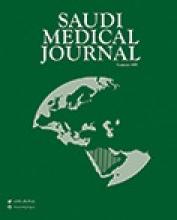Abstract
OBJECTIVE: To determine the frequency of septicemic cases in Makkah hospitals, the main pathogens causing septicemia, and to describe the prevalence of antibiotic resistance among septicemia clinical isolates.
METHODS: We performed a prospective study of 1626 septicemic cases in the 4 main hospitals in Makkah City during April 2004 to March 2005. Blood culture, isolation of organism and susceptibility to antibiotics were assessed using a routine microbiological methods.
RESULTS: Out of the 1626 septicemic cases identified, gram-positive organisms were involved in 56.6% of these episodes with coagulase-negative Staphylococci and Staphylococcus aureus being the most frequent. While Escherichia coli and Pseudomonas species were the most common among gram-negative organisms. Candida species was involved in 5.9% of all encountered organisms. Most septicemic cases were reported in male patients over 50 years, the intensive care units, Saudi patients and during Hajj season. Results also showed the frequency and antimicrobial susceptibility patterns of bacterial pathogens isolated from septicemic patients in Makkah hospitals.
CONCLUSION: The rates of antibiotic resistance among pathogens in this study, are much higher than what has been reported elsewhere in the Kingdom as well as in many of international studies.
- Copyright: © Saudi Medical Journal
This is an open-access article distributed under the terms of the Creative Commons Attribution-Noncommercial-Share Alike 3.0 Unported, which permits unrestricted use, distribution, and reproduction in any medium, provided the original work is properly cited.






